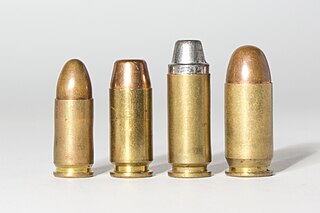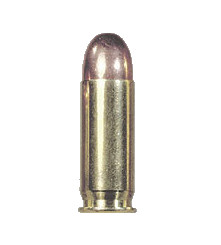
A submachine gun (SMG) is a magazine-fed automatic carbine designed to fire handgun cartridges. The term "submachine gun" was coined by John T. Thompson, the inventor of the Thompson submachine gun, to describe its design concept as an automatic firearm with notably less firepower than a machine gun. As a machine gun must fire rifle cartridges to be classified as such, submachine guns are not considered machine guns. The submachine gun was developed during World War I (1914–1918) as a close quarter offensive weapon, mainly for trench raiding. At its peak during World War II (1939–1945), millions of submachine guns were made for assault troops and auxiliaries whose doctrines emphasized close-quarter suppressive fire. New submachine gun designs appeared frequently during the Cold War, especially among special forces, covert operation commandos and mechanized infantrymen. Submachine gun usage for frontline combat decreased in the 1980s and 1990s, and by the early 21st century, submachine guns have largely been replaced by assault rifles, which have a longer effective range, have increased stopping power, and can better penetrate the helmets and body armor used by modern soldiers. However, they are still used by security forces, police tactical units, paramilitary and bodyguards for close-quarters combat because they are "a pistol-caliber weapon that's easy to control, and less likely to overpenetrate the target".

A semi-automatic pistol is a repeating handgun that automatically ejects and loads cartridges in its chamber after every shot fired, but only one round of ammunition is fired each time the trigger is pulled. The pistol's fire control group disconnects the trigger mechanism from the firing pin/striker until the trigger has been released and reset manually, unlike the self-cycled firing mechanism in fully automatic pistols.

The .40 S&W (10.2×22mm) is a rimless pistol cartridge developed jointly by American firearms manufacturers Smith & Wesson and Winchester in 1990. The .40 S&W was developed as a law enforcement cartridge designed to duplicate performance of the Federal Bureau of Investigation's (FBI) reduced-velocity 10mm Auto cartridge which could be retrofitted into medium-frame semi-automatic handguns. It uses 0.40-inch-diameter (10 mm) bullets ranging in weight from 105 to 200 grains.

The .45 ACP, also known as .45 Auto, .45 Automatic, or 11.43×23mm is a rimless straight-walled handgun cartridge designed by John Moses Browning in 1904, for use in his prototype Colt semi-automatic pistol. After successful military trials, it was adopted as the standard chambering for Colt's M1911 pistol. The round was developed due to a lack of stopping power experienced in the Moro Rebellion in places like Sulu. The issued ammunition, .38 Long Colt, had proved inadequate, motivating the search for a better cartridge. This experience and the Thompson–LaGarde Tests of 1904 led the Army and the Cavalry to decide that a minimum of .45 caliber was required in a new handgun cartridge.

The 9×19mm Parabellum is a rimless, centerfire, tapered firearms cartridge.

The .38 Super, also known as .38 Super Auto, .38 Super Automatic, .38 Super Automatic +P , .38 Super +P , or 9×23mmSR, is a pistol cartridge that fires a 0.356-inch-diameter (9.04 mm) bullet. It was introduced in the late 1920s as a higher pressure loading of the .38 ACP, also known as .38 Auto. The older .38 ACP cartridge propels a 130-grain (8.4 g) bullet at 1,050 ft/s (320.0 m/s), whereas the .38 Super pushes the same bullet at 1,280 ft/s (390.1 m/s). The .38 Super has gained distinction as the caliber of choice for many top practical shooting competitors; it remains one of the dominant calibers in IPSC competition.
The Hi-Point carbine is a series of pistol-caliber carbines manufactured by Hi-Point Firearms chambered for 9×19mm Parabellum, .40 S&W, 10mm Auto, .45 ACP, .380 ACP and .30 Super Carry handgun cartridges. They are inexpensive as they are constructed using polymers and alloyed metals resulting in a reduction of production costs and sale price. It functions via a simple direct blowback action.

Taurus Armas S.A. is a Brazilian manufacturing conglomerate based in São Leopoldo, Rio Grande do Sul, Brazil. Founded in 1939 as a tool and die forging plant, the company now consists of Taurus Armas, its firearm division, as well as other divisions focusing on metals manufacturing, plastics, body armor, helmets and civil construction.
A rim is an external flange that is machined, cast, molded, stamped, or pressed around the bottom of a firearms cartridge. Thus, rimmed cartridges are sometimes called "flanged" cartridges. Almost all cartridges feature an extractor or headspacing rim, in spite of the fact that some cartridges are known as "rimless cartridges". The rim may serve a number of purposes, including providing a lip for the extractor to engage, and sometimes serving to headspace the cartridge.

Hi-Point Firearms, also known as Strassell's Machine, Inc, is an American firearms manufacturer based in Mansfield, Ohio. All of their firearms are manufactured in several different locations in Ohio.

Star Bonifacio Echeverria, S.A. was a manufacturer of small arms in the Basque region of Spain from about 1905 until 1997.

Overpressure ammunition, commonly designated as +P or +P+, is small arms ammunition that has been loaded to produce a higher internal pressure when fired than is standard for ammunition of its caliber, but less than the pressures generated by a proof round. This is done typically to produce ammunition with higher muzzle velocity, muzzle energy, and stopping power, such as ammunition used for security, defensive, or hunting purposes. Because of this, +P ammunition is typically found in handgun calibers which might be used for paramilitary forces, armed security, and defensive purposes.

The Smith & Wesson Model 59 is a double-action pistol produced from 1971 to 1982. It was developed by Smith & Wesson from the earlier Smith & Wesson Model 39 by adapting a 14-round capacity stagger-stack magazine.

The Colt Double Eagle was a double-action / single action, semi-automatic pistol manufactured by Colt's Manufacturing Company between 1989 and 1997. It was available in standard full-size, as well as in more compact versions. It featured a decocking lever, and was chambered for several calibers. The family of models was known as the Series 90.

Kahr Arms is an American small firearms manufacturer focused on compact and mid-size semi-automatic pistols chambered for popular cartridges, including .380 ACP, 9mm Luger, .40 S&W and .45 ACP. Kahr pistols feature polymer or stainless steel frames, single-stack magazines, and double-action-only striker firing actions. Kahr Arms is part of the Kahr Firearms Group, a US-based firearms manufacturer, which also includes Thompson Auto-Ordnance and Magnum Research. The Kahr Firearms Group company headquarters is in Greeley, Pennsylvania, with a manufacturing facility in Worcester, Massachusetts.

A handgun is a firearm designed to be usable with only one hand. It is distinguished from a long barreled gun which typically is intended to be held by both hands and braced against the shoulder. Handguns have shorter effective ranges compared to long guns, and are much harder to shoot accurately. While most early handguns are single-shot pistols, the two most common types of handguns used in modern times are revolvers and semi-automatic pistols.

The KRISS Vector is a series of weapons based upon the parent submachine gun design developed by the American company KRISS USA, formerly Transformational Defense Industries (TDI).

Bond Arms Inc. is an American firearms manufacturer located in Granbury, Texas which makes derringers, the semi-automatic Bullpup9 pistol, and announced plans to put a tactical lever-action rifle into production by the end of 2023.

Wilson Combat is a custom pistol manufacturer located in Berryville, Arkansas, that specializes in customizing and manufacturing M1911A1s. First started under the name "Wilson's Gun Shop" in 1977, Bill Wilson started his new gunsmith business in the back of the family jewelry store, "Wilson's Jewelry", on the corner of Berryville's public square. In 2000, the company bought "Scattergun Technologies", and markets combat shotguns under the name "Wilson Combat Scattergun Technologies".

Gemtech is an American manufacturer of silencers (suppressors) for pistols, rifles, submachine guns, and personal defense weapons (PDWs). The company also produces ammunition and various accessories.


















